When Ladi Balogun, Group Chief Executive Officer of FCMB Group, joined the Miva Masterclass on Leadership and Innovation: Lessons From the Nigerian Banking Industry, his tone was calm but purposeful. “Leadership and innovation”, he began, “are some of the most important things to the success of businesses and countries.”
What followed was a masterclass rooted in reflection, humility, and practical wisdom, blending global insight, work history, and deeply personal stories that left students inspired to build, lead, and innovate with integrity.
In This Post
Standing on the Shoulders of Giants
Ladi Balogun began by recognising those who came before him—his late father, Otunba Subomi Balogun, founder of FCMB, who, he explained, was not only a banker but a daring visionary, and Jonathan Long, a brilliant investment banker from Oxford who played a defining role in Nigeria’s financial history. “I stand on the shoulders of giants,” he said, echoing the sentiment that every generation builds on the courage and work of those before it.
Ladi described how both men, though from vastly different backgrounds, shared common values of diligence, transparency, and innovation. Together, they demonstrated how cross-cultural partnerships, guided by shared vision and ethical leadership, can reshape a nation’s financial sector.
Of Pyramids, Cathedrals, and East Asia
To illustrate how innovation depends on knowledge transfer and continuous learning, Ladi Balogun drew comparisons from history. The Egyptian pyramids and the great cathedrals of Europe, he said, were breathtaking feats of human achievement. Yet, they are frozen in time; monuments to a past era rather than evolving systems. In contrast, China and Japan have maintained a culture of building upon what was built.
“Europe took pride in being developed, and they stopped building, and they stopped transferring the knowledge of building,” he said. Meanwhile, China’s determination to keep building—not only structures, but industries and technologies—has turned it into a modern powerhouse.
“Building is a core part of innovation.”
Building as the Core of Innovation
Ladi Balogun shared that at FCMB, the act of building is central to how they operate. Unlike many organisations that depend entirely on buying foreign technology, FCMB invests heavily in creating in-house systems and tools.
He described how this approach has made the bank more efficient, adaptable, and responsive to customer needs. Internal teams now create platforms for lending, data analytics, and customer engagement, reducing dependence on external vendors.
He said, “By building, you can innovate. By buying, you don’t really innovate. Whether as an employee or as an entrepreneur, if you want to be in an innovative company, that company must be building. And if it is not building, it’ll end up like the pyramids or the cathedrals of Egypt and Europe.”

Leadership: Vision and Execution
Leadership, Ladi Balogun noted, is not a title; it’s the ability to turn ideas into action. Quoting Warren Bennis, he said, “Leadership is the capacity to translate vision into reality.” For him, that translation happens through execution.
“People say vision without execution is hallucination. You’re just dreaming, but you know, it’s not going to happen. Real leadership is vision plus execution.”
He also drew on Dwight Eisenhower’s famous line: “The supreme quality for leadership is unquestionable integrity.” Integrity, Ladi said, builds trust, and trust motivates people to give their best. People don’t follow leaders they don’t trust. They follow those whose words and actions align.
He explained that integrity unlocks what he calls “discretionary effort”—when team members willingly go beyond their formal duties because they believe in the mission. A good leader, therefore, creates an environment where people are not forced to work harder, but are inspired to.
He reminded the audience that the measure of a great leader is how much better their followers perform. “The only way you succeed as a leader is if those who follow you outperform.”
Responsibilities and Qualities of a Leader
Ladi Balogun outlined five core responsibilities of leadership: inspiring purpose, building trust, empowering people, ensuring execution, and encouraging innovation. Each one, he said, is interdependent; none can stand alone.
“There’s a science to execution. There’s a discipline to execution. If you want to learn about execution, I would strongly advise you to find a book called The Four Disciplines of Execution (4DX).”
He described an effective leader as visionary, empathetic, decisive, and ethical. “You’ve got to have a vision. You must create an environment where your people can thrive. And the only way they can thrive is if you understand the conditions under which they will thrive.
“You have to be decisive as a leader. [Being] decisive doesn’t mean you take every decision, but you make sure decisions are taken, and you don’t procrastinate. Even if the decision is wrong, it’s better to make a decision, learn from the mistakes, and move on.”
Innovation vs. Invention
Ladi Balogun went further to distinguish between invention and innovation:
“You can invent things that don’t really create value. And you can invent things that don’t really drive growth. Two key elements of innovation are value creation and growth. Without them, maybe you’re just inventing things.”
A cardboard tractor may be inventive, but it isn’t useful. Real innovation improves lives and solves real problems.
Types of Innovation
He broke innovation down into three categories according to The Prosperity Paradox by Clay Christensen and Efosa Ojomo:
- Sustaining Innovation: This is “where a company will find a new way to do things that helps sustain and keep it alive. Sustaining innovation does not create prosperity. It may aid survival.”
- Disruptive Innovation – introduces new models that displace old ones, like Uber changing transport.
“There’s a challenge with disruptive innovation; you’re killing the business of somebody else. So economies and societies don’t necessarily grow.”
- Market-Creating Innovation – opens entirely new opportunities that lift communities out of poverty.
“[In] market-creating innovation, there was no consumption in that area before. You’re creating new consumption that didn’t exist. And that is most powerful for a country or for an industry.
“The entry of mobile phones in Nigeria was market-creating. Why? There were many services that did not exist before that were now possible because of mobile phones.”
Ladi Balogun also mentioned the sewing machine innovation, which prompted the furniture industry to create wardrobes.

Leadership and Innovation
Leadership and innovation must walk hand in hand. “A leader must provide a vision. A leader must empower the people to innovate and to drive. A leader must create a culture and an environment—that’s part of empathy—that ensures that you can get the best out of people. You should encourage experimentation. You should encourage risk-taking, but within boundaries. You should reward learning, and you should sustain growth that comes through innovation,” Ladi explained.
Vision alone cannot create progress without a culture that rewards experimentation. He encouraged future leaders to tolerate failure, learn quickly, and empower others to try new things.
According to him, the world’s most successful organisations are those that execute fast and iterate even faster.
The Power of Collaboration
Ladi Balogun emphasised that collaboration is one of the most essential qualities of effective leadership. Reflecting on his own experience, he explained that his success was made possible by building on the achievements of those who came before him.
But even for those without such direct mentorship, collaboration remains key. “If you can’t stand on the shoulders of giants, stand next to them,” he advised. “Learn from them, innovate by leveraging some of what they’ve already done, and build things together.”
Using the banking industry as an example, he described how modern API technology has transformed collaboration. In the past, software systems were built in isolation and often failed entirely when one part broke. Today, through APIs, companies can integrate the best solutions from different innovators to create stronger, more reliable systems.
Innovation and Collaboration in the Nigerian Banking Industry
Ladi took the audience on a journey through Nigeria’s banking evolution, showing how innovation has always been at the heart of the industry’s progress.
In the 1960s, most banks were foreign-owned and mainly served colonial trade. By the 1970s, indigenous banks such as Wema Bank and First Bank emerged, creating a more sustainable, locally driven system.
The 1980s and 1990s saw liberalisation, allowing private ownership. FCMB, founded in 1983, became a trailblazer despite initial resistance and the absence of foreign partners. Its success inspired the creation of others like GTBank and Zenith Bank, marking a turning point for the industry.
By the 2000s, collaboration drove technological progress. Ladi Balogun recalled how InterSwitch was formed through partnerships among banks, Telnet, and Accenture, linking ATMs nationwide and laying the foundation for Nigeria’s digital payment ecosystem.
In the early 2000s, Nigerian banks faced a challenge: customers wanted faster, more convenient ways to access their funds across different banks, but there was no shared network to make that possible. Rather than waiting for a foreign solution, Ladi Balogun and a group of banking leaders came together to create one. They pooled funds, expertise, and trust—and InterSwitch was born.
“Now, what is this an example of? Collaboration. The industry collaborating. We didn’t stay in silos,” Ladi Balogun explained.
The Rise of Fintechs
Ladi acknowledged that the success of Nigeria’s leading fintechs, such as Flutterwave, Moniepoint, Paystack, and Lemfi, lies in one key factor: their founders are engineers and builders. They understand the technical challenges that limited traditional banks and used that insight to design better, customer-focused solutions.
He linked this mindset to Miva, noting that its founder, Sim Shagaya, has always built and led innovative ventures like Konga, DealDey, and uLesson. This culture of building, Balogun explained, produces people who go on to create new ideas, such as the founder of Lemfi, an ex-Konga employee.
Ladi Balogun warned that even today’s fintech giants will face disruption from technologies like AI, blockchain, stablecoins, and crypto. However, companies led by builders will adapt, while those that rely only on buying technology will struggle to survive.
He added that in 2024, Nigeria recorded $50 billion in crypto transactions, compared to less than 10% of that amount on the stock market, clear evidence of how fast the financial landscape is changing. Even global players like JP Morgan Chase now accept crypto as collateral.
Ladi Balogun concluded that for banks and fintechs alike, engineering capability and a builder’s mindset are no longer optional; they are essential for survival and future growth.
Examples of Innovation at FCMB
To show how innovation works in practice, Ladi highlighted several milestones from FCMB’s journey. In the 1970s, its subsidiary City Securities Limited (CSL) was instrumental in democratising share ownership, allowing ordinary Nigerians to participate in the capital market for the first time. Decades later, FCMB has carried that same spirit into the digital age.
He spoke of how the bank’s investment in technology has produced homegrown solutions, such as:
1. Credit Direct Limited
Credit Direct is one of FCMB Group’s standout companies. It pioneered Nigeria’s first 24-hour loan service with the Sharp Sharp Loan product. Today, it controls about 30% of the non-bank lending market, disbursing over 10,000 loans daily using generative AI. Known for customer-friendly policies and a high satisfaction rate, Credit Direct continues to lead through innovation and empathy in lending.
2. Capital Markets and Investment Banking
FCMB is Nigeria’s leading issuer of bonds and commercial papers, raising around ₦3 trillion in 2025 alone. This has helped corporates access cheaper and more efficient financing through the capital markets rather than traditional bank loans.
3. Digital Consumer and SME Lending
Through its digital platforms, FCMB serves over 15 million customers, lending to about 2–3 million at any given time, with a loan portfolio of ₦500–₦600 billion. The focus is on responsible lending—maintaining default rates below 10%—and using AI to expand access to credit for individuals and small businesses.
4. Asset Management and Private Credit Fund
FCMB launched Nigeria’s first private credit fund, offering loans funded by pension assets rather than banks. This provides cheaper, faster financing to businesses and mirrors the $2 trillion private credit market in the U.S.
5. Rova Fintech Platform
Rova is FCMB’s new digital brand designed for African youth and SMEs. Similar to Revolut, it enables users to send, spend, save, and receive money in multiple currencies (GBP, USD, NGN). The app will soon allow cross-border transfers and plans to expand across Africa. Built with FCMB’s proprietary technology, Rova strengthens financial inclusion and supports global business connectivity.
6. Agricultural Lending
FCMB is Nigeria’s largest agricultural lender, with 10% of its loan book dedicated to smallholder farmers. Its model uses innovation to lend safely and empower rural communities, improving food security and livelihoods.
7. Artificial Intelligence and Chatbots
AI powers much of FCMB’s customer service and operations. Its chatbots, Clara (Credit Direct) and Timmy (FCMB), handle 70% of customer enquiries across web and mobile platforms, reducing costs and improving response times. AI also drives automated loan disbursements and credit decisions.
These innovations—financial, digital, and operational—reflect FCMB’s culture of building.
Bringing It All Together
In closing, Ladi Balogun reminded participants that true innovation begins with vision: a clear sense of purpose that drives creativity and progress, both personally and professionally. He emphasised that innovation also requires courage to build, take risks, and make calculated bets.
He noted that innovation flourishes in an ecosystem of capable people and strong partnerships, not in isolation. It is sustained by creating real value and sharing knowledge, rather than building empty symbols of success.
Finally, Balogun stressed that leadership plays a vital role. Leaders must not only inspire innovation but also ensure it endures. Through vision, collaboration, and commitment, innovation can transform industries and empower future generations.


